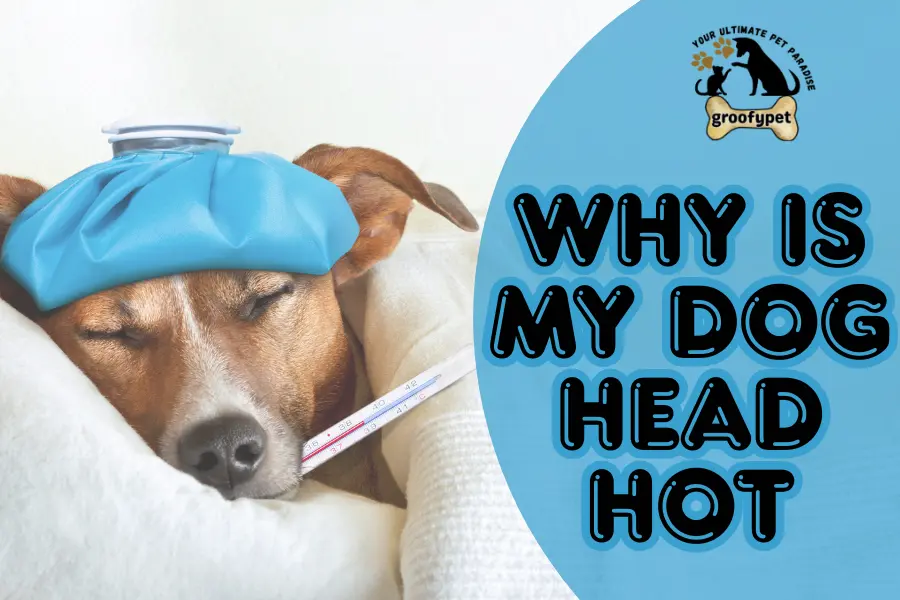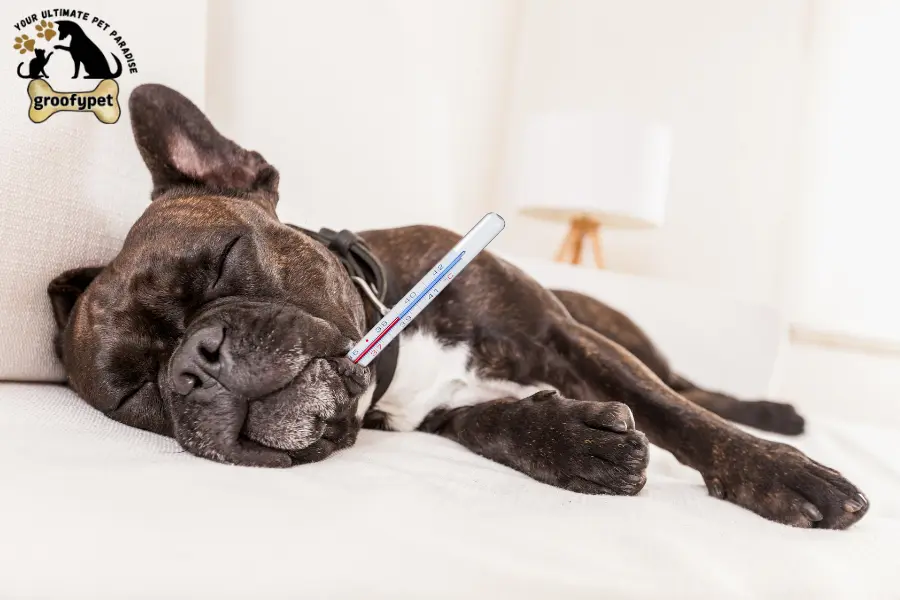
Dogs have a higher body temperature than human. Their normal range is between 101 and 102.5°F. So if you’re thinking why is my dog head hot it might just be their natural warmth. But sometimes a hot head can be a sign of fever, stress or another health issue. It’s important to know when it’s normal and when it’s not.
Have you ever touched your dog head and thought why is my dog head hot? It can feel strange especially when the rest of their body seems fine. Is it a fever or is it just normal? Many pet owners ask the same thing. Let’s break down what a warm head could really mean.
You’re worried because your dog head feels too warm. You check again and ask yourself, why is my dog head hot? You’re not sure if it’s something serious or just a normal change. You don’t want to rush to the vet for nothing but you also don’t want to ignore a real problem. This guide will help you understand the difference.
It happened while cuddling on the couch. You gave your dog a gentle pat and noticed their head felt hot. You paused and asked, why is my dog head hot? Sometimes it’s nothing but it can also be a sign your dog isn’t feeling well. Let’s find out what it could mean.
Why is my dog head hot is a question many pet owners ask. It means your dog head feels warmer than usual to the touch. This happen after sleep, exercise or time day.In some cases it may be a sign of fever or another health issue. Knowing the cause can help you to take the next steps.
Why is my dog head hot?
But there are also times when it could point to something more serious. It’s important to look at other signs your dog might be showing, like changes in energy or eating habits. A dog’s warm head can come from heat, activity, or even illness.
Is it normal for a dog head to feel warm?
Yes, in many cases, it’s normal. A dog’s average body temperature ranges from 101 to 102.5 degrees Fahrenheit, which is warmer than human temperature. So when you touch your dog head, it may feel hotter especially if they’ve been lying in the sun or just woke up from sleep. Some dog breeds also tend to run warmer than others.
You might ask, why is my dog head hot right after a nap or a walk? but that’s just their body adjusting. Puppies also often feel warmer because they’re growing quickly. Unless there are other symptoms, a warm head is usually not a problem.
Common reasons why your dog head is hot?
1.Natural body temperature
Dogs run hotter than humans. If you touch their head and it feels warm, it might just be their normal body heat. Many people worry and ask, why is my dog head hot, but in most cases, it’s just their body doing what it’s supposed to do.
2. Warm surroundings
If your dog has been sitting near a heater, in the sun, or under a blanket, their head may feel hot. Their fur holds in warmth. It doesn’t mean they are sick. Many times the heat from the environment is the reason for the warm head.
3. Physical activity
When your dog plays, runs, or gets excited, their body temperature rises a bit. Blood flow increases, and their head can feel hot to the touch. This is common and not something to panic about unless the heat stays for a long time.
4. After waking up
Right after waking, dogs may feel warmer. Their body has been still, often under blankets or snuggled into soft spots. The heat builds up, and the first thing we touch is their head, making us ask, why is my dog head hot when they wake up?
Other health problems that may cause a hot head
1. Infections
Dogs can get infections in their ears, teeth, or skin. These can cause swelling and make the area feel hot. The body sends blood to the infected part which causes warmth. If your dog is scratching one area or seems in pain it might be an infection.
2. Inflammation
Conditions like sinusitis or brain swelling can also make your dog’s head warm. These are more serious. If the warmth stays and your dog acts differently like being confused or sleep see a vet soon. Dogs cannot tell us what’s wrong, so we must watch closely.
3. Allergic reactions
Sometimes a dog’s body reacts to a food, shampoo, or even a bug bite. The reaction may cause redness, swelling, and heat on the head. You might ask, why is my dog head hot after going outside or trying a new treat? That could be the reason.
4.Pain or injury
If your dog bumps their head or has a sore area, it may become warm. Touch gently to see if they flinch. Pain or injury often brings blood to the area, making it hotter. Watch how your dog acts. If they’re avoiding touch or shaking their head, it could be due to pain.
Can stress or anxiety make my dog head warm?
Yes, stress and anxiety can raise a dog’s body temperature. When dogs are nervous, their heart rate and body temperature go up. This can make the head feel warm. Loud sounds, visitors, or new places can make a dog anxious. You may notice your dog panting, whining, or hiding.
Some dogs also pace or won’t settle. If you’re asking, why my dog head hot during fireworks or a thunderstorm, stress could be the reason.
Is a hot head in dogs a sign of heatstroke?
Sometimes, yes. Heatstroke is serious and happens when dogs overheat. It’s not just a warm head—it comes with signs like heavy panting, drooling, vomiting, or wobbling. Dogs with thick coats or flat faces, like bulldogs, are at higher risk.

If your dog has been outside in hot weather and their head is hot, check for these signs. Move them to a cool place right away and give them water. Heatstroke can be deadly, so call the vet fast if you’re worried.
When should I worry about my dog hot head?
You don’t need to worry every time your dog’s head feels warm. But if it stays hot for hours or comes with other signs like tiredness, vomiting, or shaking, call your vet. Also, if your dog stops eating or seems sad, those are warning signs. A one-time warm head is often harmless, but if it happens again and again, it’s time to check. It’s always better to be safe. Trust your gut when something feels off.
What to do if your dog head feels too hot?
First, check their surroundings. Are they in the sun or under a blanket? Move them to a cooler spot and give them water. Let them rest. If they seem normal after a few minutes, it’s likely not serious. But if you’re still asking, why is my dog head hot? Try checking their temperature. You can use a pet thermometer. If the temperature is over 103°F, call your vet. Watch for other signs like breathing problems or vomiting.
What does it mean if my dog head is hot?
If your dog head feels hot it could be normal or a sign of something else. Dogs naturally have higher body temperatures than humans. Things like physical activity waking up from sleep or warm surroundings can make the head feel hotter. But if the heat stays or comes with other signs like tiredness or loss of appetite, it could mean fever, infection or inflammation. Watch your dog closely and check for any changes in behavior.
Should I be worried if my dog feels hot?
You don’t always need to worry if your dog feels hot. Many dogs run warm naturally especially on their heads. But if the heat is strong and stays for a long time or if your dog shows signs like panting, vomiting not eating or acting different it could mean trouble. In those cases it’s best to check their temperature and call your vet. Always look at the full picture not just one sign.
Can you tell if a dog has a fever by their head?
Feeling a dog head can give you a clue but it’s not enough to confirm a fever. Some dogs have a hot head just from being active or sleeping. But the only sure way to know is by using a rectal thermometer. A temperature over 103°F is considered a fever and should be checked by a vet.
Should I be concerned if my dog ears are hot?
Warm ears on a dog are often harmless. They can get warm from being in the sun, sleeping or moving around. But if the ears are red, swollen or painful to touch there might be an ear infection or fever. If you notice scratching, head shaking or your dog avoiding touch it’s time to call your vet. Ear problems are common in dogs and are easier to treat early.
How to prevent your dog from getting too hot?
To keep your dog cool, make sure they have shade and fresh water at all times. Avoid walking them in the middle of the day when the sun is hottest. Keep them inside during heatwaves. Trim thick fur (but don’t shave fully). For breeds like huskies or bulldogs, cooling mats and fans help. When traveling, never leave them in a parked car. These steps help prevent overheating and keep your dog safe.
Should I give my dog medicine if his head is hot?
No, never give human medicine to dogs without talking to a vet. Some human drugs can be toxic to dogs. If your dog has a fever or warm head and you’re concerned, the vet will guide you. They may suggest a checkup or give you a safe medicine. Giving medicine on your own can make things worse. Always play it safe and call a professional.
Also Read : why are my dogs eyes dilated
Why Is my dog head hot?
As dog owners, we always want to ensure our furry friends feel their best. So when you notice your dog’s head feels hot, it’s natural to be concerned. While a warm head isn’t always something serious, it can sometimes signal an underlying issue. Let’s walk through the most common reasons and what you should do about them.
Why our dog head Might feel warm?
It’s not unusual for your dog’s head to feel warm, especially after exercise, naps, or playtime. But if it’s unusually hot or paired with other symptoms, here’s what could be going on:
1. Fever in Dogs
A warm head or dry, hot nose could mean your dog has a fever. This can happen due to infections, illness, or even recent vaccinations. Watch for lethargy, shivering, loss of appetite, and use a rectal thermometer to check their temperature—it should stay between 100.5°F and 102.5°F. Anything higher could mean a fever that requires a vet visit.
2. Stress or Anxiety
Just like us, dogs get hot when they’re stressed. Their heart rate rises, and they may pant, pace, or shake. If your dog’s head feels hot during a stressful moment like loud noises, vet visits, or new environments it might be due to an adrenaline spike. Products like calming chews with B vitamins and magnesium can help ease their anxiety.
3. Reaction to Vaccinations
Mild warmth after a vaccine is a normal immune response. It usually goes away within a day. Keep an eye on their behavior. If they act sluggish or develop other symptoms, talk to your vet.
4. Allergies
Allergic reactions—whether to food, pollen, or fleas—can sometimes raise a dog’s temperature. These are often accompanied by itching, swelling, or hives. If allergies are common for your pup, seasonal care and allergy-friendly diets might help.
5. Heatstroke or Overheating
Dogs are vulnerable to heat exhaustion, especially in hot cars, after long walks, or during play on warm days. Short-nosed breeds like French Bulldogs and Pugs are at higher risk. Signs include heavy panting, drooling, red gums, and vomiting. Cool them down with wet towels and get to a vet quickly if symptoms worsen.

6. Dehydration
If your dog hasn’t had enough water, they may show signs like a hot head, dry gums, sunken eyes and low energy. Gently pinch their skin if it doesn’t bounce back fast it may be dehydration. This can escalate quickly especially if they’re sick or have diarrhea.
7. Infections
Infectious diseases like kennel cough, distemper, or parvo can cause fevers. These conditions are contagious and often come with vomiting, coughing or weakness. Fever is one way your dog’s body fights infection—so a hot head could be an early clue.
8. Puppy Strangles (Juvenile Cellulitis)
In young puppies,a rare immune disorder called juvenile cellulitis can cause swelling, skin sores, and a hot head especially near the eyes and muzzle. Veterinary care is essential.
9. Skin or Ear Infections
Skin conditions like ringworm, or ear infections, can heat up nearby areas. You might notice head shaking, scratching or discharge from the ears. Infections cause localized warmth, redness and discomfort.
10. Autoimmune Disorders
Conditions like lupus or pemphigus cause the immune system to attack the dog own tissues leading to inflammation and heat. Pemphigus is known to cause skin blisters and is one of the more common autoimmune issues in dogs.
11. Injury or Trauma
A bump on the head or neck—whether from rough play or an accident—can cause swelling and warmth. If your dog seems in pain or you notice a lump, get them checked out.
12. Inflammation
Inflammation is the body’s way of healing, but it often comes with heat, swelling, and redness. Whether from injury or illness, inflammation around the head can make it feel noticeably warmer.
Recognizing Canine fever & hot head symptoms
Besides a hot head, here are signs that may point to overheating or fever:
- Heavy panting
- Bright red gums or ears
- Excessive drooling
- Vomiting or diarrhea
- Confusion or lethargy
- Seizures in severe cases
Diagnosing Why Your Dog Head Feels Hot
- 1. Physical Exam: Your vet will check vitals, including temperature, heart rate, and any signs of discomfort or swelling.
- 2. Blood Tests: These help identify infections or immune disorders.
- 3. Imaging: X-rays or MRIs can uncover hidden injuries or issues in the head, brain, or neck area.
How to Treat a Hot Head in Dogs?
Veterinary Treatment: Your vet may recommend fever reducers like NSAIDs (e.g., carprofen or meloxicam) or treat underlying issues with antibiotics or allergy meds.
At-Home Care Tips:
- Keep your dog cool and well-hydrated
- Avoid strenuous activity during peak heat.
- Use cooling mats, damp towels, or fans.
- Always provide shade and fresh water.
- Prevention Tips for Dog Owners
- Never leave your dog in a hot car.
- Provide water at all times.
- Groom regularly to avoid trapped heat.
- Avoid outdoor play during the hottest part of the day.
- Use cooling products in summer months.
- When to Call the Vet
- Don’t wait if your dog has a hot head along with:
- Vomiting or diarrhea
- Seizures
- Lethargy
- Dry nose and no appetite
- Trouble breathing or walking
- Sudden behavior changes
- Early diagnosis can make a huge difference in recovery
Frequently Asked Questions
How can I tell if my dog has a fever without a thermometer?
You can check for signs like warm ears, dry nose, tiredness, or not eating. These may point to a fever, but they aren’t exact. A thermometer is the best way to know.
Does my dog’s head get hot when excited?
Yes, it can. Activity raises body temperature, so playing or getting excited can make your dog’s head feel warm.
Why does my dog head feel hot only at night?
At night, dogs may sleep under blankets or in warm places. That heat stays on their skin and head, making them feel warmer.
Can puppies have hotter heads than adult dogs?
Yes, puppies grow fast and often have higher energy and body temperatures. Their heads may feel hotter than adult dogs.
What is the normal temperature for a dog?
The normal temperature is 101 to 102.5°F. Anything over 103°F should be checked by a vet.
Should a dog head be warm?
A slight warmth is normal. But if it feels abnormally hot, especially with other symptoms, monitor closely and talk to a vet.
Why is my dog head hot when I pet them?
Touch increases blood flow, making their head feel warm. It’s usually normal unless it’s unusually hot or persistent.
Can you tell a dog has a fever by touch?
Not always. Use a thermometer to be sure. Relying on touch alone can be misleading.
Why are my dog head and ears hot?
This might signal fever, inflammation, or ear infection. Check for discharge, redness, or discomfort and consult a vet if needed.
Why is my Chihuahua’s head hot?
Chihuahuas often have a higher metabolism, which means a slightly higher normal body temperature. Still, rule out fever or illness if something seems off.
Final Thoughts
It’s common for pet parents to wonder, why is my dog head hot? and in many cases, it’s totally normal. Dogs are warm-blooded animals with different body temperatures than humans. Their head can feel hot after playing, sleeping, or lying in the sun.
But sometimes, it could be a sign of something more, like fever, infection, or even heatstroke. Knowing when it’s okay and when to act is key. Keep an eye on your dog’s behavior, and when in doubt talk to your vet. A little caution goes a long way in keeping your furry friend healthy and happy.




